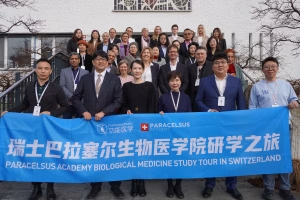The Alzheimer treatment with PRP opens up exciting possibilities for new therapeutic approaches to neurodegenerative diseases. By using the body’s own healing factors, this innovative therapy offers a way to counteract degenerative processes and support cognitive performance. PRP could thus become a promising tool to support brain health and help preserve mental function.
In this newsletter, we invite you to take a closer look at neurodegenerative diseases such as Alzheimer’s. You’ll learn how biological medicine – and specifically PRP therapy – can positively influence the progression of these conditions and help maintain valuable quality of life. The Paracelsus Dental Clinic also shares insights into how oral health can affect the development and progression of neurodegenerative diseases like Alzheimer’s – an often overlooked aspect.
When Cells Age: How the Process Affects Brain Health
Aging is a natural process in which our bodily functions gradually decline. Over time, our cells divide more slowly, the body’s repair mechanisms weaken, and small damages accumulate – such as to cell structures or DNA. This leads not only to visible changes like gray hair, wrinkles, or benign skin growths but also to internal processes such as reduced muscle strength, a weakened immune system, and an increased risk of illness.
Some cellular damage develops so severely that it increases the risk of serious diseases—especially so-called neurodegenerative diseases. These affect the central nervous system and cause nerve cells to slowly die off. They are triggered not only by aging itself but also by environmental toxins, stress, inflammation, or genetic factors.
Examples of Neurodegenerative Diseases:
- Alzheimer’s Disease – common in older age, leads to memory loss and confusion
- Parkinson’s disease – causes tremors, stiff muscles and movement problems
- Amyotrophic Lateral Sclerosis (ALS) – leads to muscle weakness due to nerve cell loss
- Frontotemporal Dementia (FTD) – changes personality, language, and behavior
- Multiple System Atrophy (MSA) – similar to Parkinson’s but progresses more quickly and is more complex
- Corticobasal Degeneration (CBD) – motor and cognitive symptoms, usually asymmetric
A common feature of many neurodegenerative diseases is the limited regenerative capacity of nerve cells in the central nervous system. Once damaged or lost, nerve cells typically cannot be replaced – leading to a progressive loss of function over time.
Alzheimer: When Memory Slowly Fades
The diagnosis of Alzheimer’s changes lives – for those affected and their families. At first, it’s just small things: a name is forgotten, appointments are missed, and orientation is lost. But the disease progresses – slowly but steadily – taking away the abilities that were once second nature.
Alzheimer’s is the most common form of dementia. Already today, more than 55 million people worldwide live with dementia, and that number is growing. According to the “Global Burden of Disease” study from 2019, the number could nearly triple by 2050. About 60 to 70% of these cases are due to Alzheimer’s (1).
A characteristic feature of Alzheimer’s is the accumulation of beta-amyloid plaques in the brain. These plaques not only disrupt communication between nerve cells but also trigger inflammatory responses that further damage the nerve cells. Additionally, tau fibrils form during the disease, destabilizing the cell structure and leading to the death of nerve cells. In the long term, this has a significant impact on memory, language, orientation, and personality.
Some cellular damage develops so severely that it increases the risk of serious diseases—especially so-called neurodegenerative diseases. These affect the central nervous system and cause nerve cells to slowly die off. They are triggered not only by aging itself but also by environmental toxins, stress, inflammation, or genetic factors.
Typical Signs of Alzheimer’s:
- Primarily affects older individuals
- Early symptoms include memory lapses, such as forgetting names or conversations
- Daily life shows difficulties with planning, orientation, or understanding
- Patients may withdraw and appear irritable or confused
- As the disease progresses, those affected become increasingly dependent on support
- There is currently no cure, but therapies are available that can slow the progression of the disease
PRP for Alzheimer’s: An Alternative Therapeutic Approach to Support Regeneration
Although Alzheimer’s is currently incurable and the regenerative capacity of nerve cells in the brain is limited – once nerve cells are damaged, they cannot be easily replaced – modern therapies like PRP (Platelet-Rich Plasma) offer a supportive option. PRP promotes the body’s healing processes by reducing inflammation and enhancing the regenerative potential of remaining healthy cells.
At Paracelsus Klinik Lustmühle, we follow a holistic treatment approach that aims to provide individualized support for the body and its regenerative abilities. We place special emphasis on reducing inflammatory processes and promoting the body’s self-healing powers.
PRP works in this regard: It is obtained from the patient’s own blood. First, a small amount of blood is drawn and processed in a centrifuge. During this process, the blood components are separated into their various components. The result is a concentrated plasma that contains a much higher concentration of platelets (blood cells) than normal blood. These platelets are crucial because they contain numerous growth factors and bioactive proteins that play a key role in tissue regeneration and healing.
The activated platelets release a variety of growth factors during PRP treatment, including:
- Platelet-Derived Growth Factor (PDGF): Promotes cell division and regeneration
- Transforming Growth Factor-Beta (TGF-β): Supports wound healing and tissue growth
- Vascular Endothelial Growth Factor (VEGF): Stimulates the formation of new blood vessels, improving the supply of nutrients to tissues
- Epidermal Growth Factor (EGF): Promotes cell renewal and tissue healing
- Insulin-like Growth Factor (IGF): Promotes the growth and repair of nerve cells and other tissues
Intranasal Application: Direct Access to the Brain
A special potential lies in the administration of PRP via the nasal mucosa. This so-called intranasal application uses the direct access through the olfactory nerve (Nervus olfactorius) to transport the growth factors specifically into the central nervous system – bypassing the bloodstream. In this way, the active ingredients can act where they are needed: in the brain, directly at the affected neuronal structures (2).
In advanced cases of the disease, intrathecal administration may also be considered in individual cases – in this procedure, PRP is injected under sterile conditions into the lumbar region of the spinal cord. This minimally invasive procedure is individually assessed and potentially offers an additional therapeutic option for advanced disease stages.
Effect of PRP
While PRP was initially used in sports and trauma medicine to accelerate wound healing and tissue regeneration, recent studies show an increasingly broad therapeutic potential. Researchers are now intensively discussing the neuroprotective and neuroregenerative properties of PRP (3,4).
Protection and Regeneration Factor in Alzheimer’s
Several studies suggest that PRP can exhibit a variety of neuroregenerative and protective properties. The growth factors contained in PRP have a positive effect on essential processes in the nervous system, including (5,6):
- Proliferation: The multiplication of nerve cells or their precursor cells.
- Migration: The targeted movement of newly formed cells to their designated location in the brain.
- Zellschutz: Protecting neurons from premature cell death.
- Differenzierung: The development of immature cells into functional nerve cells.
Immune Modulation in Parkinson Models
Another positive effect was observed in the Parkinson’s mouse model: PRP was able to regulate the activity of so-called microglia – specialized immune cells in the brain. These cells play a central role in chronic inflammatory processes in the brain.
PRP reduced the neuroinflammatory response (i.e., inflammation in the brain) – a promising indication that PRP may also have immunomodulatory effects, potentially positively influencing pathological inflammatory processes in the central nervous system (3).
The goal of PRP therapy is not to cure Alzheimer’s, but to:
- Reduce inflammatory processes in the brain,
- Improve the supply and function of remaining nerve cells,
- Counteract neurodegenerative changes,
- and thus slow down the progression of the disease or preserve cognitive abilities for a longer period of time.
As with all therapies at the Paracelsus Klinik Lustmühle, the use of PRP is not standardized, but integrated into a holistic treatment concept – individually tailored to the disease stage, the physical condition, and the personal goals of the patient.
Our therapeutic approaches for Alzheimer's include, among others:
Plasmapheresis: A gentle blood purification procedure that removes harmful substances such as inflammation-promoting proteins, autoantibodies, or environmental toxins from the blood. This relief can reduce inflammatory processes and ease the central nervous system.
Micronutrient Infusions: A targeted supply of essential vitamins, minerals, trace elements, and antioxidants. These strengthen cell functions, improve regeneration, and support energy production – a crucial factor, especially in the brain.
Measures to support mitochondria and nerve cells: This includes, for example, Interval Hypoxia-Hyperoxia Training (IHHT), which improves oxygen utilization in the cells and stimulates the mitochondria, as well as other procedures that specifically focus on the protection and stabilization of nerve cells.
Some of our therapeutic approaches have already been discussed in more detail in a previous post. If you would like to delve deeper into the background of neurodegenerative diseases and complementary medical treatment strategies, you can find further information here.
Conclusion
Although there is currently no cure for Alzheimer’s, especially biological medical approaches offer promising opportunities to slow the progression of the disease and improve the quality of life for those affected. Therapies like PRP and other individually tailored treatment approaches have already yielded positive results and contribute to opening new perspectives. A look into research shows that new therapeutic approaches, such as stem cells or intranasal insulin, are being further developed worldwide. These advancements provide hope and highlight the dynamic progress in the field of neurodegenerative diseases.
If you would like to learn more about our PRP therapy for Alzheimer’s or wish to schedule a personal consultation, feel free to contact us by phone at +41 71 335 71 71 or via email at info@paracelsus.com.
References:
- GBD 2019 Dementia Forecasting Collaborators (2022). Estimation of the global prevalence of dementia in 2019 and forecasted prevalence in 2050: an analysis for the Global Burden of Disease Study 2019. The Lancet. Public health, 7(2), e105–e125.
- Anitua E. et al. (2015). Intranasal PRGF-Endoret enhances neuronal survival and attenuates NF-κB-dependent inflammation process in a mouse model of Parkinson’s disease. Journal of controlled release: official journal of the Controlled Release Society, 203, 170–180.
- Sills E. et al. (2023). Intrathecal autologous thrombin-activated condensed platelet cytokines in chronic neurodegenerative disease: A hypothesis for anti-inflammatory and regenerative response. Neuro endocrinology letters, 44 6, 418-425.
- Sánchez M. et al. (2017). Platelet-rich plasma, a source of autologous growth factors and biomimetic scaffold for peripheral nerve regeneration. Expert opinion on biological therapy, 17(2), 197–212.
- Moon J. et al. (2024). Platelet-rich plasma protects hippocampal neurons and memory functions in a rat model of vascular dementia. Anatomy & Cell Biology, 57, 559 – 569.
- Demir E. & Karagoz M. (2020). Platelet-Rich Plasma (PRP) is a Potential Self-Sourced Cognition Booster in Elderly Mice. Experimental Aging Research, 46, 139 – 153.




